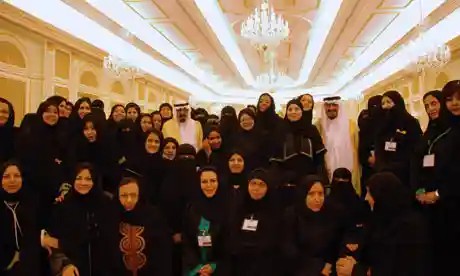Muna AbuSulayman
One of 10 items cross-posted from SEMIONAUT.
The image of women in the Kingdom of Saudi Arabia (KSA) in the West, and the world generally, is strongly associated with being covered in black. Women were hidden in several ways — not only was a Saudi woman’s face hidden but even her voice was not supposed to come out in public. In some segments of the culture, even a woman’s name was not supposed to be mentioned.
Beginning with the education drive launched in the 1960s by King Faisal, many things have changed. The illiteracy of Saudi women was eroded and increasing numbers of girls went on to higher education. Some pioneers took up public positions as radio or TV presenters, as well as prominent jobs in various organizations. However, in KSA a woman was still supposed to obey her husband and support him without even taking any credit. She was supposed to bear burdens and sacrifices in silence.
Outside the home the Saudi woman could work as a teacher in girls-only schools or colleges. By the 1980s she could also have clerical jobs in ladies-only bank branches or hospitals. The medical field was actually one of the first sectors to open to women. After all, in a gender-segregated society, women needed women doctors to tend to them. But in all these professional environments there was a glass cubicle containing women as the restrictions on visibility remained dominant.

It took a number of economic and cultural variables as well as the personal leadership of King Abdullah to finally tip the scales. Abdullah, who ascended to the throne in 2005, made a point of pushing women to the fore on several public occasions — for example, by including speeches from women (who were still visually out of sight) at some events. Then he started to appear in photos taken at unsegregated gatherings — for example, when he attended the graduation ceremony of the medical school in Riyadh. This sent strong signals to men and women alike that women can come out now, and participate actively in life.
The media has played an important role in creating and feeding this movement. Saudi had female radio and TV presenters for quite a while, but in recent years some of them have become superstars. For example, because of her role as co-host on the popular TV show Kalam Nawaem (Softly Speaking; think of The View), Muna AbuSulayman [shown above; she’s now head of Prince Alwaleed Bin Talal’s philanthropic organization], has been promoted as the ‘Saudi Oprah.’
Saudi TV stations have started to compete in developing programs featuring high-achieving Saudi women., and the pages of Saudi newspapers are often splashed with photos of women, albeit always wearing the traditional abayah and headwear covering at least part of the hair. But even the abayahs are becoming more and more colorful and ‘visible’ (both in design and actual colors). They are going beyond being ‘covers’ to being also a personal expression of style. Saudi girls and women are now flooded with signals shifting their paradigm and giving a new code — ‘The sky is the limit’ — for what it means to be a ‘Saudi woman’.
This is not to suggest that all Saudi women are rushing out to seek a career; still, they are starting to see themselves and their roles differently. I’ve interviewed hundreds of women, and I’m struck by how differently their self-perception is today, compared with what it was a decade ago. The Saudi woman now wants to believe that she has an active role in her own life. How does she realize this new self-image? Sometimes through seeking to be a high-achieving career woman, but also through cooking or house-cleaning, or in allowing herself to indulge in little luxuries. Also, she’s more insistent, now, on participating actively in family decisions — from which brands to select to raising the children, to choosing where to live.
In the KSA we’re seeing the emergence of a media-created role model: super-women who attain the highest educations and go on to illustrious careers while remaining perfect wives, mothers, and devout Muslims. These and other communications that reflect the Saudi woman’s new self-perception are generally more attractive than those that depict women as ignored, unappreciated, or weak. Saudi women are learning they can roar; it’s interesting to see the culture shift in order to accommodate and encourage this movement.
Original publication date: December 2010.


